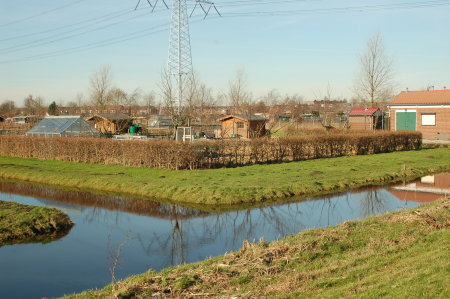
Here’s what my garden looks like from a distance. Canals on three sides keep it dry. Around the corner to the right is also a canal. The canals also function as a security barrier, keeping out unwanted visitors.
The water level is only 30-45cm (1-1.5 feet) below the surface of the garden, keeping the ground at least a little wet almost all the time.
Sometimes the ground is too wet. Over the weekend I was digging in the greenhouse. Even though the weather was clear and warm (just like this picture), when I came back on Monday I found it raining inside the greenhouse because the water was evaporating from the freshly dug earth and condensing on the inside of the glass. I think it may be a challenge to keep the inside of the greenhouse dry enough throughout the summer.
In case you are all wondering why I posted pictures of the rain water collection containers a few days ago, when I have all of this lovely water right next to the garden, let me assure you it is not suitable for use in the garden. There is too much dumping, legal and otherwise, and the water is very dirty. We had to dredge some of the canals a few weeks ago, and what came out smelled like a mixture of motor oil and sewage. There is enough flow through the canals that the water is exchanged about once a day with fresh water that comes from the ground together with rain water, and this flow is enough to keep our gardens clean.
In theory at least I could dig a hole, a pond if you like, that I could use to grow water plants or as a source of water for the garden. I think with this I might have the problem of mosquitoes or other insects. I don’t know of anyone else in the garden complex who has tried this. Perhaps with a little work I could create a balanced ecosystem with fish and so on. Anyway, this is a project for another year, first a garden!

